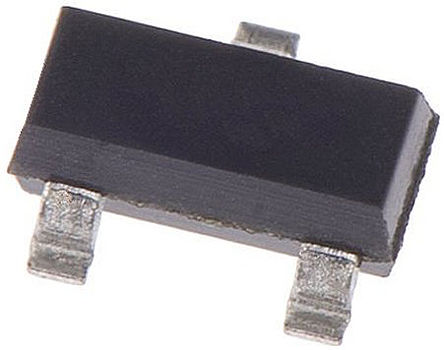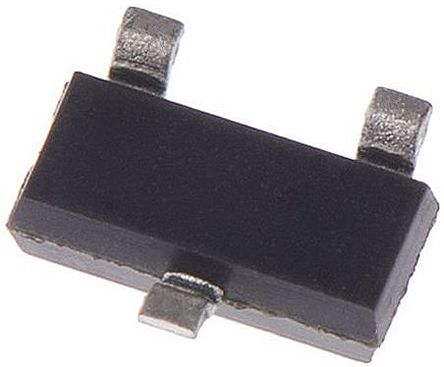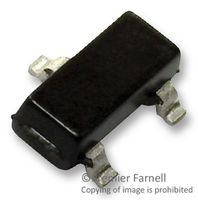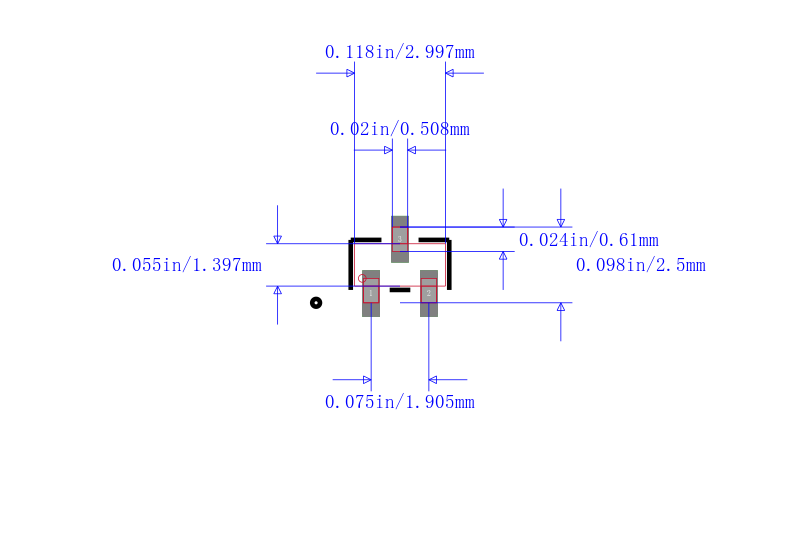






NXP PBSS5160T 单晶体管 双极, PNP, 60 V, 220 MHz, 270 mW, 1 A, 350 hFE
集电极-基极反向击穿电压VBRCBOCollector-Base VoltageVCBO| -80V \---|--- 集电极-发射极反向击穿电压VBRCEOCollector-Emitter VoltageVCEO| −60V 集电极连续输出电流ICCollector CurrentIC| -900mA/-0.9A 截止频率fTTranstion FrequencyfT| 220MHz 直流电流增益hFEDC Current GainhFE| 350 管压降VCE(sat)Collector-Emitter SaturationVoltage| -330mV/-0.33V 耗散功率PcPoWer Dissipation| 270mW/0.27W Description & Applications| General description PNP low VCEsat Breakthrough In Small Signal BISS transistor in a SOT23 TO-236ABsmall Surface-Mounted Device SMD plastic package. Features Low collector-emitter saturation voltage VCEsat High collector current capability IC and ICM High efficiency due to less heat generation Reduces Printed-Circuit Board PCB area required Cost-effective replacement for medium power transistors BCP52 and BCX52 Applications Major application segments: Automotive、Telecom infrastructure、Industrial、Power management、DC-to-DC conversion、Supply line switching、Peripheral driver、Driver in low supply voltage applications e.g. lamps and LEDs、 Inductive load drivers e.g. relays, buzzers and motors 描述与应用| 一般说明 PNP低VCE(饱和)突破性小信号(BISS),采用SOT23(TO-236AB)小型表面贴装器件(SMD)塑料包装。 特点 低集电极 - 发射极饱和电压VCE监测 ?高集电极电流能力IC和ICM ?由于产生的热量少,高效率 ?降低印刷电路板(PCB)面积 中等功率晶体管的成本效益的替代?BCP52和BCX52 应用 主要应用领域: ?汽车,电信基础设施,?工业,电源管理,DC-DC转换,切换供电线路,外设驱动器,驱动器在低电源电压应用(如灯和LED),?感性负载驱动器(如继电器,蜂鸣器和电机)
针脚数 3
极性 PNP
耗散功率 270 mW
击穿电压集电极-发射极 60 V
集电极最大允许电流 1A
最小电流放大倍数hFE 100
直流电流增益hFE 350
工作温度Max 150 ℃
工作温度Min -65 ℃
耗散功率Max 1.25 W
安装方式 Surface Mount
引脚数 3
封装 SOT-23
长度 3 mm
宽度 1.4 mm
高度 1 mm
封装 SOT-23
工作温度 -65℃ ~ 150℃
产品生命周期 Unknown
包装方式 Cut Tape CT
制造应用 Lighting, Power Management, Industrial, Automotive, Motor Drive & Control, Communications & Networking, Signal Processing
RoHS标准 RoHS Compliant
含铅标准 Lead Free
REACH SVHC标准 No SVHC
REACH SVHC版本 2015/12/17



| 型号/品牌 | 代替类型 | 替代型号对比 |
|---|---|---|
PBSS5160T NXP 恩智浦 | 当前型号 | 当前型号 |
PBSS5160T,215 恩智浦 | 功能相似 | PBSS5160T和PBSS5160T,215的区别 |
FMMT591 威世 | 功能相似 | PBSS5160T和FMMT591的区别 |
ZXTP2039F 威世 | 功能相似 | PBSS5160T和ZXTP2039F的区别 |